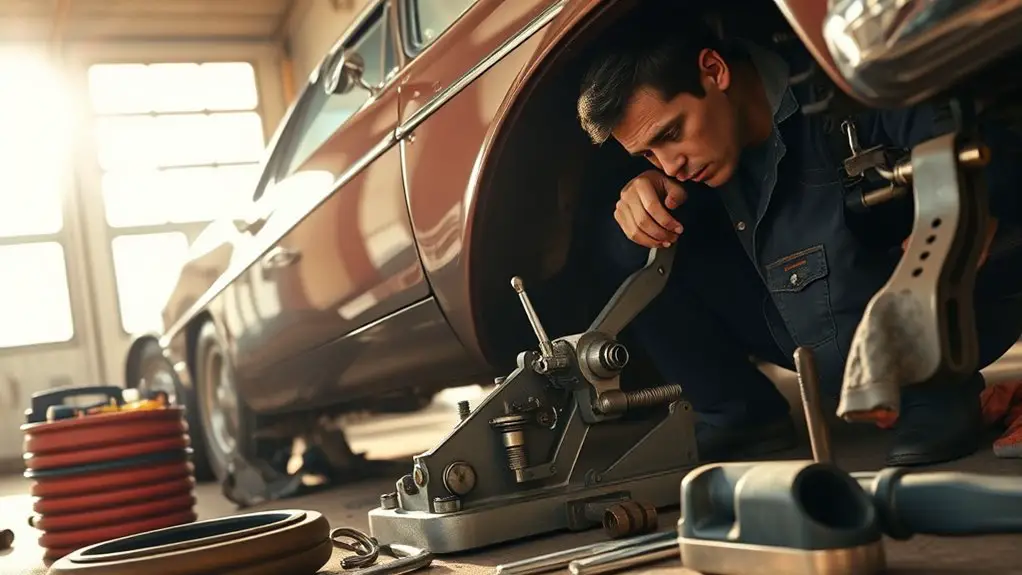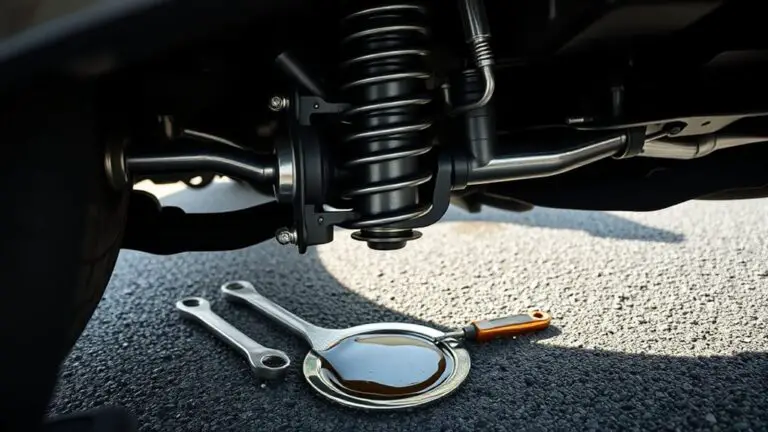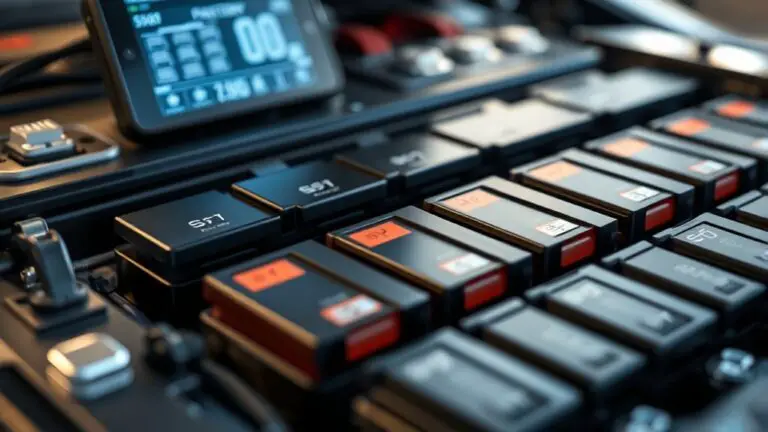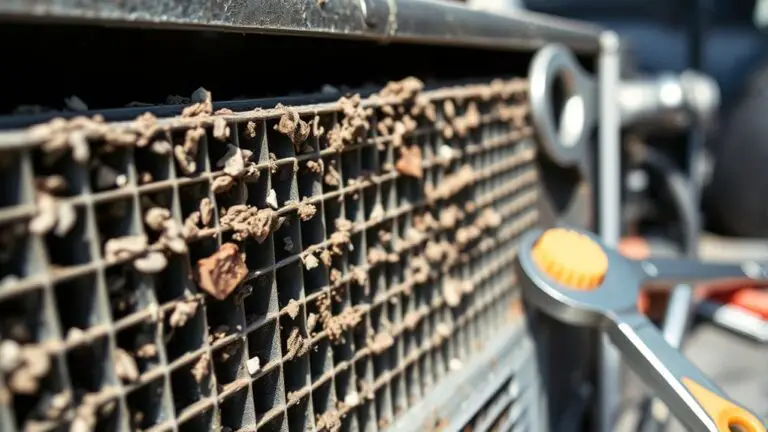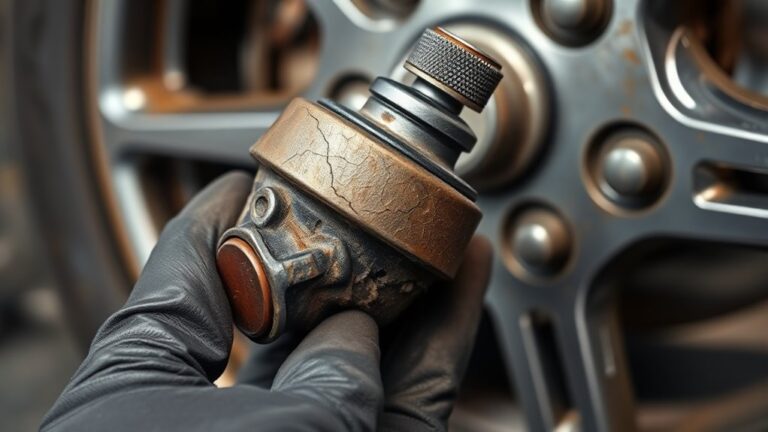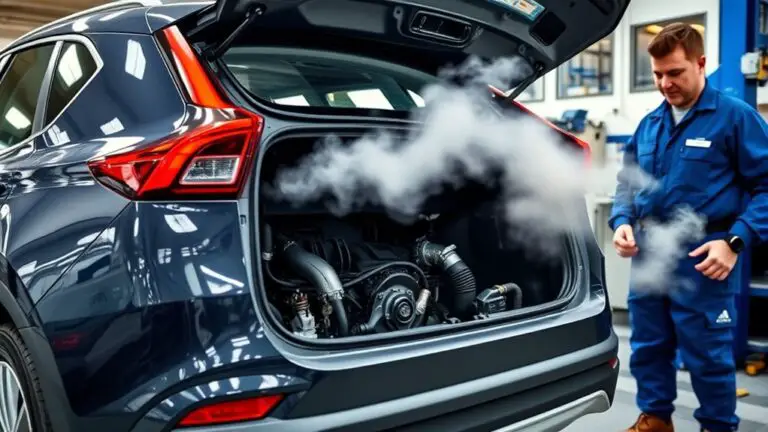Preventive Maintenance to Avoid Clutch Pedal Issues in Older Classic Car
To avoid clutch pedal issues in your classic car, prioritize regular inspections and maintenance. Check for wear on the clutch disc and pressure plate, and monitor fluid levels, replacing the fluid every two years. Guarantee proper lubrication of components to reduce friction and extend lifespan. Adjust the clutch pedal height and free play to enhance comfort and functionality. There’s much more you can do to keep your clutch system in top shape, so let’s explore further.
Understanding the Clutch System in Classic Cars

The clutch system in classic cars is a critical component that guarantees smooth gear changes, making it essential for peak performance. Understanding the clutch components is crucial for any classic car enthusiast. Primarily, the system consists of the clutch disc, pressure plate, and release bearing, which work together to engage and disengage the engine from the transmission. When you press the pedal, you’re manipulating pedal mechanics that activate these components, guaranteeing seamless shifts between gears.
Regular inspection of these components can prevent unexpected failures, enhancing your driving freedom. Pay attention to wear on the clutch disc and confirm the pressure plate maintains adequate force. The release bearing should also be free of play. By keeping a close eye on these elements, you can enjoy the thrill of driving your classic car without the worry of clutch-related issues, allowing you to fully embrace the open road ahead.
Signs of a Failing Clutch Pedal
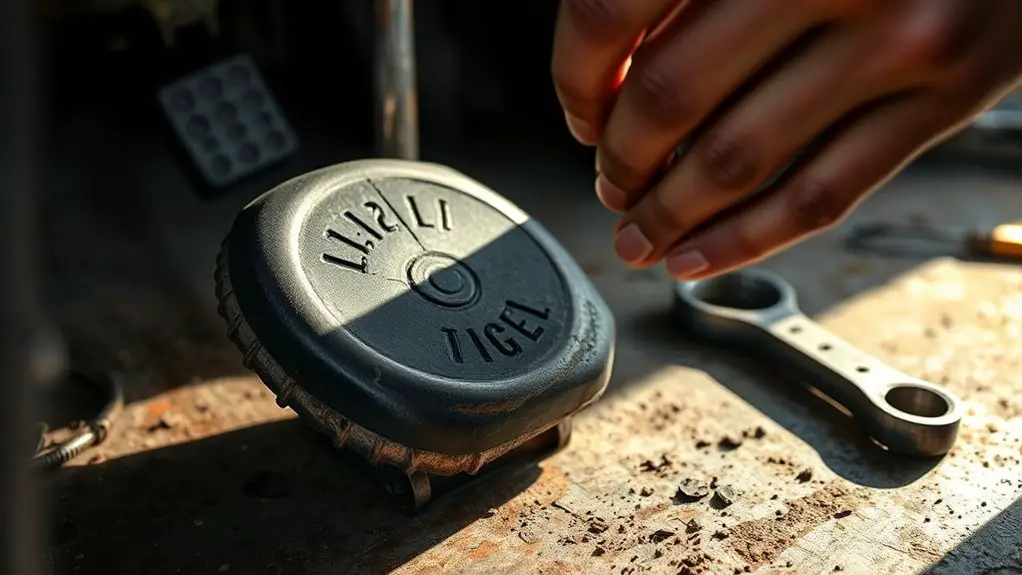
When you’re experiencing unresponsive clutch engagement, it’s a clear indicator that something’s amiss. Excessive pedal travel and grinding or slipping gears further highlight potential issues with your clutch system. Recognizing these signs early can help prevent more severe damage and costly repairs.
Unresponsive Clutch Engagement
If you’re experiencing unresponsive clutch engagement in your classic car, it could indicate a failing clutch pedal system. This issue often manifests as a lack of pedal responsiveness, making it difficult to shift gears seamlessly. You might notice that the pedal feels stiff or doesn’t return to its original position after you release it. These symptoms can result from various factors, including low hydraulic fluid levels, air in the hydraulic system, or worn clutch components. Ignoring these signs can lead to further damage and even complete clutch failure, compromising your driving experience. Regular inspections and timely maintenance can help maintain proper clutch engagement and guarantee that your classic car remains a joy to drive, preserving that sense of freedom on the road.
Excessive Pedal Travel
Excessive pedal travel can be a clear indicator of a failing clutch pedal system in your classic car. When you notice that the pedal feels spongy or requires more movement than usual, it’s often a sign of excessive wear in the clutch components. This can lead to inefficient engagement and disengagement, ultimately affecting your driving experience. Regular pedal adjustment is essential to maintain ideal performance. If you find that adjustments aren’t resolving the issue, it might be time to inspect the linkage, master cylinder, or even the clutch itself for wear. Addressing excessive pedal travel promptly can help prevent more severe problems down the road, ensuring you enjoy the freedom of driving your classic car without complications.
Grinding or Slipping Gears
As you drive your classic car, grinding or slipping gears can signal a failing clutch system that demands your attention. These symptoms typically indicate clutch engagement issues, which can lead to significant gear shifting problems. If you feel resistance or hear unusual noises when shifting, it’s essential to diagnose the issue promptly. A worn clutch plate or a faulty release bearing might be the culprit. Regular inspections can help you catch these problems early, ensuring you maintain the freedom and performance of your vehicle. Ignoring these signs could lead to more severe damage, restricting your driving enjoyment. Don’t wait until it’s too late; address clutch issues now to keep your classic car running smoothly.
Importance of Regular Inspections
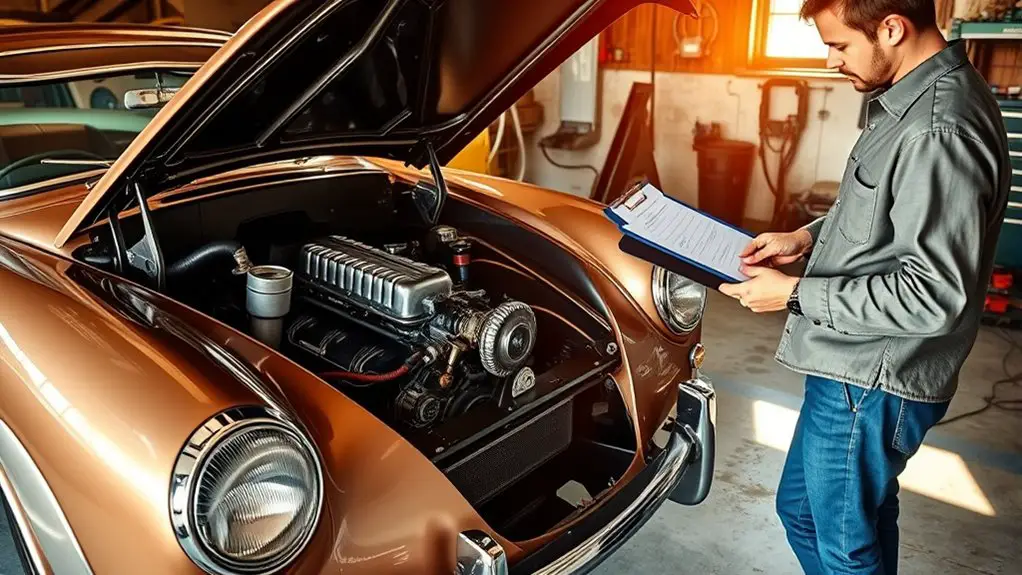
Regular inspections of your classic car are essential for early problem detection, ensuring you catch issues before they escalate. This proactive approach not only enhances safety but also helps in maintaining cost-effective solutions for repairs. By prioritizing inspections, you can preserve the integrity and performance of your vehicle over time.
Early Problem Detection
While classic cars exude charm and nostalgia, they also require diligent care to maintain their performance and integrity. Regular inspections can serve as an early warning system, helping you identify potential clutch pedal issues before they escalate. Utilizing diagnostic tools, you can assess the condition of essential components, ensuring that any wear or malfunction is detected promptly. By monitoring fluid levels, checking for leaks, and examining pedal responsiveness, you empower yourself to address minor problems before they become major headaches. This proactive approach not only enhances your driving experience but also preserves the value and longevity of your classic car. Remember, early problem detection is key to enjoying the freedom of the open road without the worry of unexpected breakdowns.
Safety Assurance
Guaranteeing your classic car is safe on the road hinges on the significance of regular inspections. These check-ups help maintain vital safety features and identify potential issues before they become serious problems. By adhering to driving precautions, you can enjoy your vehicle without worry.
Here’s a quick overview of essential inspection components:
| Inspection Component | Frequency | Significance |
|---|---|---|
| Brake System | Every 6 months | Prevents brake failure |
| Clutch Mechanism | Annually | Guarantees smooth shifting |
| Tire Condition | Monthly | Enhances grip |
| Fluid Levels | Monthly | Prevents overheating |
Regular inspections not only enhance safety but also preserve the freedom of driving your classic car confidently.
Cost-Effective Maintenance Solutions
Cost-effective maintenance solutions hinge on the importance of regular inspections, which can prevent unexpected expenses down the line. By consistently checking your clutch system, you’ll identify potential issues before they escalate. This proactive approach not only saves you money but also extends the life of your classic car. Consider implementing cost-effective upgrades like high-quality lubricants or adjustable pedal assemblies; these enhancements can greatly improve performance without breaking the bank. Additionally, budget-friendly repairs, such as replacing worn-out components instead of entire systems, can keep your car running smoothly. Prioritize these inspections to guarantee your vehicle remains reliable and maintain that sense of freedom on the road. Regular maintenance is your best defense against costly breakdowns.
Checking and Replacing Clutch Fluid
To maintain ideal performance in your classic car, regularly checking and replacing the clutch fluid is essential. The clutch fluid, typically a hydraulic fluid, plays a vital role in the operation of your vehicle’s clutch system. Over time, moisture can enter the fluid, degrading its performance and leading to potential clutch pedal issues.
Start by locating the clutch fluid reservoir, usually situated near the master cylinder. Check the fluid level; it should be within the marked range. If it’s low, top it off with the appropriate fluid type specified in your owner’s manual.
For peak performance, you should perform a fluid replacement every two years or as recommended. This involves draining the old fluid completely, flushing the system with new fluid, and ensuring there are no air bubbles trapped within the lines. By routinely checking and replacing the clutch fluid, you’ll help maintain your classic car’s freedom and driving pleasure.
Lubrication of Clutch Components
Proper lubrication of clutch components is essential for maintaining smooth operation and prolonging the lifespan of your classic car’s transmission system. You’ll need to understand the different types of lubricants available and how to apply them effectively. This guarantees peak performance and minimizes wear on the clutch assembly.
Importance of Lubrication
While you may not think about it often, lubrication plays an essential role in the performance and longevity of clutch components in classic cars. Regular lubrication reduces friction, which can lead to premature wear and tear. By ensuring proper lubrication, you reap significant lubrication benefits, including smoother operation and enhanced responsiveness of the clutch pedal. It’s vital to establish a lubrication frequency tailored to your vehicle’s usage and conditions. For instance, if you drive your classic car frequently or in challenging environments, you may need to lubricate more often. Neglecting this maintenance can result in costly repairs down the line. Prioritizing lubrication helps maintain your car’s performance, allowing you to enjoy the freedom of the open road without worry.
Types of Lubricants
Effective lubrication relies not only on frequency but also on the right types of lubricants suited for clutch components. For peak performance, consider using synthetic oils, which offer superior heat resistance and reduced friction, making them ideal for classic car clutches. These oils maintain viscosity over a broader temperature range, ensuring smooth operation even in extreme conditions.
Additionally, specific grease types are essential for components like the clutch release bearing. Look for high-temperature greases that can withstand the demands of clutch operation without breaking down. Always check compatibility with your car’s materials to prevent degradation. By choosing the right lubricants, you’ll enhance the longevity and responsiveness of your clutch system, keeping your classic car in peak condition.
Application Techniques
To guarantee ideal performance of clutch components, it’s essential to apply lubricants correctly. Start by gathering your maintenance tools, including a grease gun and appropriate brushes. When you perform a clutch adjustment, make sure you clean all surfaces before applying lubricant. Use a light, even coat on pivot points and the release bearing to minimize friction. Avoid over-lubricating, as excess grease can attract dirt and debris, leading to more issues. Pay special attention to the clutch fork and the throw-out bearing, as they require consistent lubrication for smooth operation. Regular checks and maintenance will help you avoid clutch pedal problems in your classic car. Proper application techniques not only enhance performance but also extend the lifespan of your clutch components.
Adjusting Clutch Pedal Height and Free Play
Adjusting the clutch pedal height and free play is essential for guaranteeing smooth gear shifts and overall drivability in classic cars. Proper pedal height measurement guarantees that you maintain the right distance for comfortable operation, preventing excessive strain on your leg. Start by checking your vehicle’s specifications for the recommended height. Use clutch adjustment techniques to modify the pedal position, usually through the adjusting nut on the clutch master cylinder or near the pedal assembly.
Next, assess the free play, which is the amount of pedal movement before the clutch engages. Ideally, free play should be around 1/4 to 1/2 inch. Adjust this by turning the adjustment screw or nut until you achieve the desired amount. Regularly checking and adjusting these parameters will enhance your driving experience and prolong the life of your clutch system, keeping your classic car operating smoothly and efficiently.
Inspecting Clutch Linkage and Cables
Inspecting the clutch linkage and cables is a critical step in maintaining the performance of your classic car’s clutch system. Begin with a thorough clutch cable inspection to check for fraying, corrosion, or any signs of wear. These issues can lead to failures that affect your driving experience. Next, verify that the linkage is properly adjusted; misalignment can cause inconsistent pedal action and affect engagement.
To adjust the linkage, look for the adjustment points on the linkage arms and cables. You’ll want to make small adjustments, testing the pedal feel after each change. Confirm that there’s adequate free play to prevent unnecessary strain on the system. Regular inspections and adjustments not only enhance your clutch performance but also extend its lifespan, allowing you the freedom to enjoy your classic car without the stress of unexpected issues.
Monitoring Clutch Wear and Tear
Regularly monitoring clutch wear and tear is essential for maintaining the performance and safety of your classic car. A thorough clutch inspection can help identify issues before they escalate, ensuring that your driving experience remains enjoyable. Pay attention to the pedal’s engagement point; if it feels inconsistent, it’s time for a pedal adjustment.
| Clutch Condition | Action Required |
|---|---|
| Normal Wear | Routine inspection |
| Slight Slippage | Adjust the pedal height |
| Excessive Wear or Noise | Replace clutch assembly |
Proper Driving Techniques for Classic Cars
Driving a classic car requires a different approach compared to modern vehicles, especially when it comes to handling the clutch and gear shifts. Mastering proper shifting techniques is essential for smooth operation and longevity. Always engage the clutch fully before shifting gears, and avoid riding the clutch pedal, which can lead to premature wear.
Throttle control plays a critical role in your driving experience. When accelerating, smoothly apply the throttle while releasing the clutch, ensuring you don’t stall the engine or cause unnecessary strain. Remember to downshift gradually when decelerating; this helps maintain control and allows for a smoother shift.
Practicing these techniques regularly will not only enhance your driving freedom but also prolong the life of your classic car’s clutch system. Embrace the unique characteristics of your vehicle, and enjoy the thrill that comes with driving a piece of automotive history.
Storing Your Classic Car Correctly
Properly storing your classic car is essential to preserve its condition and longevity. You need to guarantee proper storage practices to assure vehicle protection against the elements and potential damage. Here are some key steps to follow:
- Clean the Exterior: Wash and wax your car to protect the paint and prevent rust.
- Change Fluids: Replace engine oil, coolant, and fuel to prevent contamination and corrosion.
- Use a Quality Cover: Invest in a breathable car cover to shield your vehicle from dust and moisture.
- Maintain Tire Pressure: Inflate tires to the recommended pressure to avoid flat spots during storage.
Seeking Professional Help When Needed
While you may feel confident in your ability to maintain your classic car, there are times when seeking professional help is necessary to guarantee peak performance and preservation. Clutch pedal issues, in particular, can be complex and may require the expertise of professional mechanics. If you notice unusual noises, difficulty engaging gears, or a spongy pedal feel, it’s essential to consult an expert.
Professional mechanics possess the specialized knowledge and tools to diagnose problems accurately, ensuring that repairs are done correctly the first time. They can also provide expert advice on preventive measures, helping you avoid future issues. Remember, your classic car is an investment; protecting it with the right maintenance and timely professional input can save you both time and money in the long run. Don’t hesitate to reach out for help when your car’s performance is at stake; it’s a wise decision that fosters freedom on the road.
Building a Maintenance Schedule for Longevity
Establishing a maintenance schedule is crucial for maximizing the longevity of your classic car, as it helps guarantee that all essential components receive regular attention. By defining clear maintenance intervals, you can effectively ward off potential issues that may arise from neglect.
To maintain consistency, consider incorporating the following elements into your schedule:
- Fluid checks: Regularly inspect and replace engine oil, transmission fluid, and brake fluid.
- Tire maintenance: Rotate tires and check pressure monthly to prevent uneven wear.
- Brake inspections: Examine brake pads and rotors every 6 months to ensure peak performance.
- Scheduling reminders: Utilize digital calendars or apps to set alerts for upcoming maintenance tasks.
Frequently Asked Questions
How Often Should I Replace My Clutch in a Classic Car?
You should replace your clutch every 60,000 to 100,000 miles, depending on driving style and conditions. Notably, about 70% of clutch failures stem from improper use or lack of maintenance. Keeping a regular maintenance schedule is essential; check for signs of clutch wear, like slipping or difficulty shifting. Regular inspections can help you catch issues early, ensuring your classic car remains enjoyable and reliable, giving you the freedom to hit the road with confidence.
Can I Use Modern Fluids in My Classic Car’s Clutch?
Yes, you can use modern fluids in your classic car’s clutch, but make certain they have classic compatibility. Some modern hydraulic fluids can be detrimental due to their chemical compositions, which may harm older seals and components. It’s essential to check compatibility before switching. Always consult your vehicle’s manual or a specialist to confirm the right choice, guaranteeing you maintain that freedom on the road without compromising your classic’s integrity.
What Tools Do I Need for Clutch Maintenance?
For clutch maintenance, you’ll need a few essential tools. Start with a clutch alignment tool to guarantee proper positioning. A socket set will help you remove and tighten components, while a torque wrench makes sure you’re applying the correct force. Don’t forget screwdrivers for any fasteners and pliers for gripping. Having a reliable jack and jack stands is also vital for safety during your work. With the right tool selection, you’ll tackle clutch issues effectively.
Are There Specific Brands Recommended for Clutch Components?
When it comes to clutch components, you’ll want to take into account brands like Exedy, ACT, and Luk. These brands are known for their high component quality and reliability. Using reputable manufacturers guarantees you’re investing in parts that’ll perform well and last longer. It’s essential to match the clutch components with your vehicle’s specifications for peak performance, so always check compatibility before purchasing. This way, you can enjoy the freedom of smooth driving without worries.
How Do Driving Habits Affect Clutch Lifespan?
Your driving habits greatly impact your clutch’s lifespan. If you engage the clutch smoothly and avoid riding it while driving, you’ll enhance its durability. Aggressive driving styles, like rapid starts and frequent shifts, can lead to premature wear. Maintaining proper clutch engagement is essential; excessive slipping or sudden releases can stress the components. By adopting a more measured driving style, you’ll not only enjoy a smoother ride but also extend the life of your clutch.

